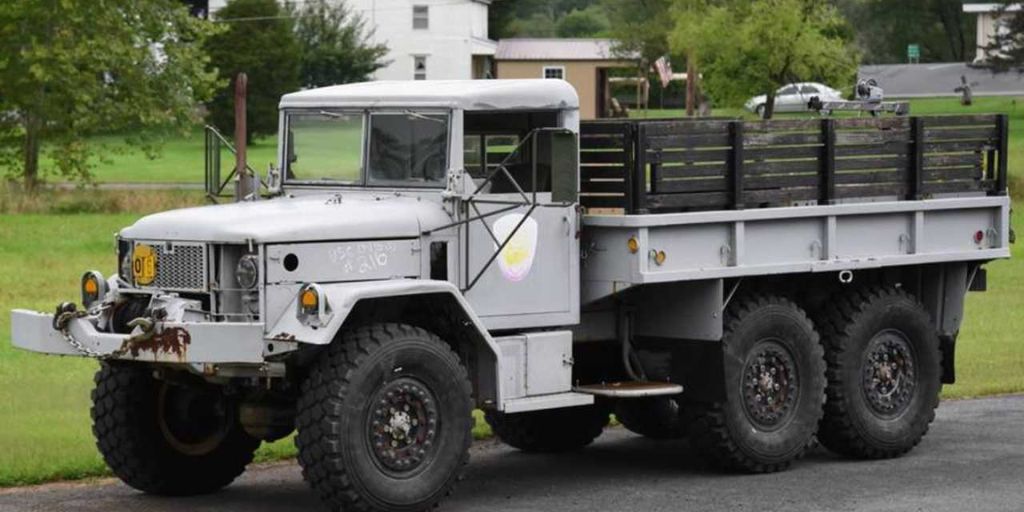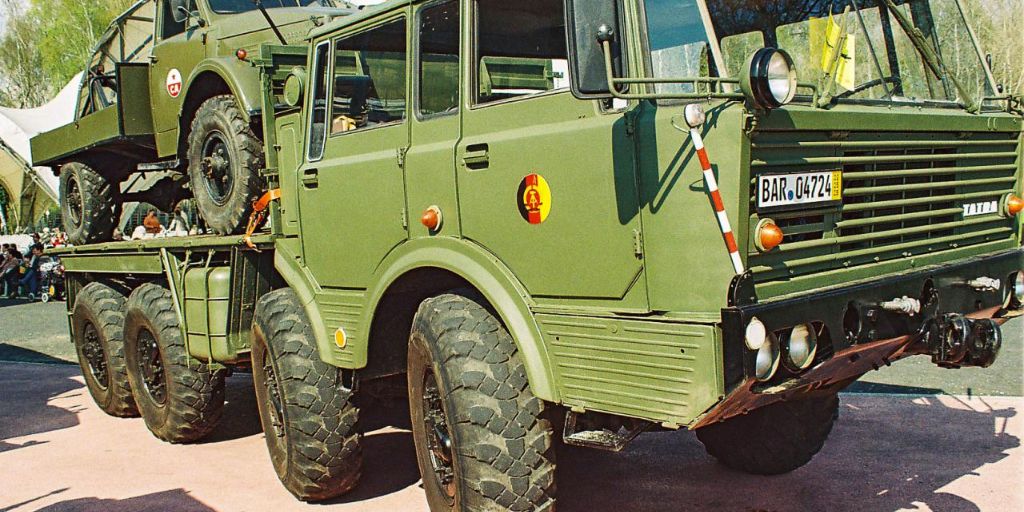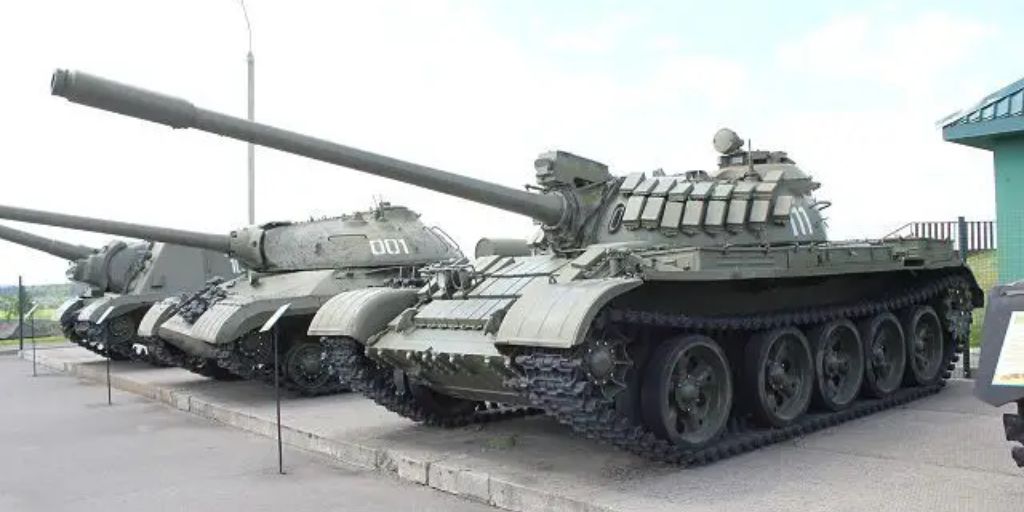The Cold War, a global standoff between ideological superpowers, was more than a battle of politics and proxy wars—it was a technological arms race that extended deep into the mechanical guts of military vehicles.
While much has been written about nuclear arsenals, spy satellites, and stealth aircraft, far less attention has been paid to one of the most important components of Cold War mobility: the engines.
These engines, often hidden beneath layers of armor or inside rugged transport machines, were designed to survive and perform under the most extreme conditions imaginable.
The Cold War period—from the late 1940s through the early 1990s—witnessed a massive expansion in military engineering.
Vehicles had to operate in arctic tundras, sweltering deserts, muddy swamps, and nuclear-blasted landscapes. Engines were expected not just to power tanks and trucks, but to do so reliably after being stored for years, exposed to radiation, or submerged in water.
This led to a wave of highly specialized engine designs that combined brute strength with surprisingly innovative technology.
In the United States, NATO countries, and especially the Soviet Union, engine designers were tasked with building machines that could keep moving in the event of total war.
Some designs were utilitarian, others borderline experimental. Many of these engines, particularly those from Eastern Bloc countries, have remained shrouded in secrecy, myth, and engineering legend.
This is the untold story of those engines—the diesel brutes of Soviet tank divisions, the amphibious powerplants of East German recon vehicles, and the nuclear-hardened turbines of American military experiments.
It’s a tale of over-engineering, of strategic necessity, and of a world bracing for war that (thankfully) never came. And yet, decades later, many of these machines—and their engines—are still running, still echoing the paranoia and power of the Cold War.
Also Read: Why Farmers Swear by These Engines for Decades?
The Requirements of Cold War Engineering
The Cold War created unique engineering demands. Military planners envisioned battlefields ranging from European plains to Siberian permafrost and even radioactive wastelands. Engines needed to be:
-
Ultra-reliable in adverse conditions
-
Easy to repair with minimal tools
-
Fuel-flexible, often capable of running on diesel, kerosene, or jet fuel
-
Powerful enough to move heavy armor across difficult terrain
-
Resistant to EMPs and nuclear fallout
-
Low-maintenance for long-term storage and rapid deployment
These criteria shaped the development of engines in ways unseen in civilian automotive history. Many innovations from this period—modular engine blocks, high-compression diesels, sealed ignition systems—originated from military programs.
Soviet Diesel Dominance: V-2 and Its Descendants
The Soviets were pioneers in rugged diesel technology, especially for tanks. At the heart of their armored might was the V-2 engine, a V12 liquid-cooled diesel first developed in the 1930s and refined during World War II. By the Cold War, this engine had evolved into several variants used in tanks like the T-54, T-62, and T-72.
Key features of the V-2 series:
-
1,200+ lb-ft of torque
-
Simple mechanical injection for reliability
-
All-aluminum construction to reduce weight
-
Designed for modular repairs in the field
Later versions, such as the V-46, powered the T-72 tank with around 780–840 horsepower and had preheating systems for extreme cold starts in Siberian environments.
Despite being loud, smoky, and unrefined by Western standards, these engines were virtually indestructible.
They could run while leaking oil, burning unfiltered fuel, or even missing a cylinder or two. Soviet doctrine emphasized redundancy and survivability—an engine’s ability to “keep going” trumped everything else.
U.S. Powerplants: From Detroit Diesels to Gas Turbines
American engineering focused heavily on multi-fuel engines. Early Cold War tanks used gasoline engines, like the Ford GAA V8 in the M4 Sherman, but safety concerns led to a shift toward diesels.
By the 1960s, the Continental AVDS-1790 series—a massive air-cooled V12 twin-turbo diesel—powered tanks like the M60 Patton. With 750+ hp and the ability to run on diesel, JP-4, or kerosene, it represented a robust, versatile design.
However, the most radical leap came with the AGT-1500 gas turbine engine in the M1 Abrams. This engine, developed by Lycoming, could:
-
Produce 1,500 horsepower
-
Operate in extreme temperatures
-
Run on diesel, jet fuel, or gasoline
-
Start quickly and deliver immediate torque
Gas turbines offered unmatched performance but came with high maintenance demands and poor fuel economy. Still, the AGT-1500 became the face of Cold War American armored power—more aircraft engine than conventional diesel.
Cold Weather Challenges: Arctic and Subzero Engineering
One of the Cold War’s unique battlegrounds was expected to be the Arctic and northern Europe. Both NATO and the Warsaw Pact built engines capable of starting and operating in -40°C or colder.
Solutions included:
-
Engine pre-heaters: Electric or fuel-fired units to warm coolant and oil before startup.
-
Double batteries: Wired in parallel for added cold cranking amps.
-
Multi-viscosity oils: Engineered for subzero flow.
-
Compression-release valves: Letting engines spin freely until oil pressure built up.
Soviet engineers took this further. Some vehicles like the BTR-60 had secondary hand-crank starting systems. Others had flame-start systems—literally injecting diesel into the intake and igniting it to heat the engine block.
Amphibious Vehicle Engines: Power Meets Waterproofing
Cold War strategy relied on fast river crossings and swamp operations. This led to vehicles like the Soviet BRDM and BMP series, and the U.S. M113 APC, all of which used specially sealed engines to function underwater or while swimming.
Key engine features included:
-
Fully waterproof ignition systems
-
Snorkel-equipped air intakes
-
Pressurized crankcases to keep water out
-
Corrosion-resistant cooling systems
The Soviet UAZ-469 recon jeep had a basic yet durable inline-4 engine that could be completely submerged as long as the snorkel stayed above water. Its simplicity—no computer, no fragile wiring—made it ideal for unpredictable warzones.
East German and Warsaw Pact Designs
Not all innovation came from the USSR or the U.S. East German and Polish engineers made their mark with vehicles like the IFA W50 truck and Tatra 813, which featured air-cooled, high-torque diesel engines. These engines were:
-
Built with modular cylinder heads
-
Capable of running on low-grade diesel
-
Equipped with cold-start ether injection
Czechoslovakia’s Tatra V12 air-cooled diesel, found in the OT-64 armored personnel carrier, was another highlight. It had independent cooling fans, redundant fuel systems, and over 300 hp—massive for a wheeled vehicle of its size.
Aircraft-Derived Engines and Experimental Concepts
In the pursuit of unconventional designs, engineers experimented with engines adapted from aircraft. Soviet designers once tested a turboprop-driven tank concept, while U.S. engineers played with rotary engines and nuclear-powered prototypes.
The Convair X-6 was a proposed nuclear-powered bomber with a compact nuclear reactor instead of a conventional jet engine. Though it never entered service, it reflects the extremity of Cold War thinking.
Meanwhile, the Chrysler TV-8, a bizarre 1950s concept tank, proposed using a turbine engine with a nuclear backup generator. The project never left the drawing board but speaks volumes about the scale of ambition—and paranoia—during the Cold War.
Engines Built to Survive Nuclear War
Certain Cold War engines were specifically hardened to survive and function after a nuclear detonation. Features included:
-
Faraday cage shielding for electronics
-
Lead-lined cabling and engine bays
-
EMP-resistant ignition systems
-
Overpressure systems to prevent contamination
The M35 Deuce and a Half, a workhorse truck for NATO forces, used a multifuel engine (the LD-465) capable of burning almost anything flammable. It could theoretically run after a nuclear blast, delivering troops and gear across contaminated terrain.
Legacy and Survivability Today
Surprisingly, many Cold War vehicles still operate today in civilian, collector, or military reserve roles:
-
T-72 tanks are still in service in over 40 countries.
-
The M113 APC, despite its age, is still used by dozens of militaries.
-
Soviet GAZ trucks and UAZ jeeps are beloved by off-roaders for their indestructible engines.
Collectors have restored vehicles like the BMP-1 or BRDM-2, often with their original diesel engines intact. These powerplants, though rough by modern standards, prove the Cold War engineering mantra: build it to last.
Real Cold War Vehicles and Their Legendary Engines
T-55 with the V-55 Engine: A Soviet Staple
The T-55 tank was the backbone of Soviet armored forces during the Cold War, produced in the tens of thousands. It was powered by the V-55, a direct descendant of the original V-2 diesel.
This V12, 38.8-liter diesel engine made 580 horsepower—not remarkable by modern standards, but more than adequate for a vehicle designed to engage and survive on the front lines of Europe or Asia.
What made the V-55 unique wasn’t raw power but resilience. It was capable of operating on poor-quality diesel or kerosene, and featured a built-in oil centrifuge and dual fuel filters to deal with contaminated fluids—crucial during a breakdown in wartime logistics.
The T-55’s engine compartment was designed for easy access, allowing trained crews to swap out or rebuild the engine with minimal equipment, even in battlefield conditions.
M35 ‘Deuce and a Half’: American Multi-Fuel Utility
The M35 2½-ton truck, affectionately called the “Deuce and a Half,” was a Cold War workhorse across the U.S. military and its allies.
Its standard engine, the LD-465 multifuel inline-six, could run on a wide range of fuels: diesel, kerosene, JP-8 jet fuel, and even gasoline in emergencies. While not powerful (around 134 hp), it prioritized reliability, parts availability, and versatility.

Stories abound of soldiers pouring everything from lamp oil to heating fuel into M35s during field ops—and the trucks still started.
The engine’s simplicity (no electronic fuel injection, no complex wiring) made it practically immune to EMPs, a significant advantage in a nuclear scenario. Today, many M35s are still in use among collectors, farmers, and preppers who value their durability.
The Tatra 813: Czechoslovakian Cold War Monster
A lesser-known marvel, the Tatra 813 was a heavy-duty military truck designed in Czechoslovakia. Its air-cooled V12 diesel produced 270 horsepower and drove all eight wheels with locking differentials.
This engine was built to function in everything from the Arctic to deserts, and its air-cooled design removed the risk of coolant freezing—a constant concern in Soviet-aligned countries.
The Tatra’s modular design let mechanics remove entire axle assemblies or engine components quickly. It could ford deep rivers with a snorkel and even haul tanks on a flatbed trailer through the Carpathian mountains. To this day, Tatra trucks are revered in off-road and expedition communities for their unique design and endurance.
UAZ-452 “Bukhanka”: The Soviet Breadbox
Nicknamed the “Bukhanka” (or “loaf of bread”) for its boxy shape, the UAZ-452 was a Cold War-era utility van powered by a 2.4-liter inline-4 engine making about 75 horsepower.
What it lacked in power it made up for in off-road capability and engine simplicity. Used for medical evacuation, communications, and light transport, the Bukhanka’s engine was built with oversized pistons and steel timing gears, reducing failure points.
Anecdotes from Russian veterans speak of these engines starting in -30°C weather with nothing more than a shot of diesel and a hand crank. Some are still in service in rural Siberia, with the same engines running after decades of abuse and minimal maintenance.
The story of Cold War engines is one of immense pressure, both literal and political. These engines weren’t designed for comfort, efficiency, or even long-term environmental compliance.
They were built to function in the worst-case scenarios of global warfare: blistering heat, radioactive fallout, flooded terrain, and total infrastructure collapse. And remarkably, many succeeded at those impossible goals.
The diesel behemoths of the Soviet T-72, the gas turbines of the Abrams, and the amphibious diesels of Warsaw Pact APCs tell a story of mechanical resilience.

Every clatter of an aging Cold War engine today is a whisper from an era when humanity stood on the brink. In a world paralyzed by “what if,” engineers answered with “what will work—no matter what.”
These engines were not just machines—they were military policy forged in steel, built for the unthinkable. And while the Cold War thawed, many of these engines still survive, still run, still move across fields and deserts, reminding us of a time when survival wasn’t just about speed or firepower, but about whether your engine would start the morning after a nuclear night.
As these machines age and become artifacts of history, they offer more than just nostalgia—they embody a philosophy of engineering rooted in hard reality.
Build it tough. Build it simple. Build it to survive. That’s the legacy of Cold War engines—a legacy still running strong, long after the ideologies that spawned them have faded.
Also Read: The Most Trusted Engines in Disaster Zones Around the World

